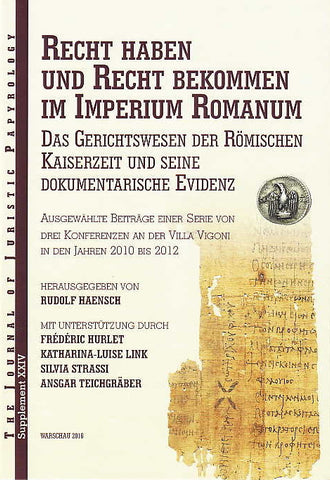Recht haben und Recht bekommen im Imperium Romanum
80,00 $
ISBN: 978-83-938425-3-7
Description: hardback, 790 pp. (24x17cm)
Condition: new
Weight: 1505g.
Recht haben und Recht bekommen im Imperium Romanum, Das Gerichtswesen der Römischen Kaiserzeit und seine dokumentarische Evidenz, ed. by Rudolf Haensch, JJP Supplement vol. 24, Warsaw 2016
In front of the Justice and on the Sea, we are in the hands of God: The legal system of the imperial era in the light of the documentary evidences. Three tri-national conferences in the Villa Vigoni. The scientific view of Roman jurisdiction is still dominated by the two major law compilations from Late Antiquity, the Codices Theodosianus and Iustinianus. Especially Modern Roman legal historians base their descriptions mostly upon these sources. However, these compilations only allow an insight into the legal system at the time of their promulgation, that is to say the end of the Vth and the VIth century AD. Even for this period, the insight is more about the intended than the actual reality, about the norm rather than its application and the problems occurring by applying Roman law. However, jurisdiction was an important element, if not the most important one, of Roman rule in Italy and the provinces; representatives of Roman power were in charge of judgments for all significant litigations. Therefore, if Rome's subjects got into contact with Roman governors or other representatives, it was mostly during litigation. The large amount of epigraphical and papyrological documents published during the last century provides much more detailed and authentic information on the reality of the legal system, its strengths and weaknesses, especially during the High Empire, than both codices. Unfortunately, until recently, this documentation has not been much used by legal historians and other researchers in Roman government. Three conferences, which took place in the Villa Vigoni at Lake Como, aimed to initiate a detailed and comprehensive discussion of these sources by publishing new documents, providing overviews of the state of source material regarding different aspects of Roman jurisdiction and discussing these aspects in detailed studies. Specialists from Germany, Italy and France took part in these discussions according to the concept of tri-national conferences. The outcome of these meetings presented in this 800 pages volume offers a detailed and updated picture of the Roman and post-Roman administration of justice since the Principate till the Late Antiquity, studied both from the side of the central institutions and from the provincial milieu. The books is thus an indispensable tool for every historian of Antiquity, not only legal ones, but also focusing on institutional history of the Empire.
I. Zur Gerichtspraxis zentraler Institutionen der Hohen Kaiserzeit
Frédéric Hurlet, Les origines de la juridiction impériale: Imperator Caesar Augustus iudex
Jean-Pierre Coriat, Ľempereur juge et son tribunal à la fin du Principat: Un essai de synthèse
Frédéric Hurlet, Entre juridiction civique et juridiction impériale: La sphère de compétences du proconsul.
Andrea Jördens, Die Strafgerichtsbarkeit des praefectus Aegypti
Rudolf Haensch, Im Schatten Alexandrias: Der iuridicus Aegypti et Alexandreae
Francesca Lamberti, La giurisdizione nei municipia dell’occidente romano e il cap. 84 della lex Irnitana
Silvia Strassi, Prassi giuridico-amministrativa nella χώρα egiziana: Fra lex romana e diritto locale
Christopher J. Fuhrmann, How to kill a bishop: Organs of Christian persecution in the third century
II. Zur Gerichtspraxis zentraler Institutionen der Spätantike
Katharina Wojciech, Die Gerichtsbarkeit des praefectus urbi über Senatoren unter Theoderich: Verfahrensrechtliche Kontinuität und politischer Pragmatismus
Rudolf Haensch, Die Protokolle der Statthaltergerichte der spätantiken Provinzen Ägyptens
Sandra Scheuble–Reiter, Zur Rechtsprechung des curator rei publicae/λογιστής in Oxyrhynchos
Dominic Moreau, The papal appeal court in the sixth century: The example of the Roman Synod of 531
III. Strukturelle Fragen
Benjamin Kelly, Petitions with requests for registration from Roman Egypt
Bernhard Palme, Eingaben an Militärs im spätantiken Ägypten
Roberto Mascellari, La descrizione di atti criminosi e violazioni nei papiri: ὕβρις, αἰκία, πληγαί, βία
Claudia Moatti, Les erreurs de statut et l’idée de liberté dans l’espace judiciaire romain impérial jusqu’au IIIe siècle
Alfons Bürge, Typisches und Untypisches bei der Urteilsfindung
Jean-Jacques Aubert, La validité des actes des déchus (Codex Theodosianus XV 14)
Leanne Bablitz, Iconographic continuity in the scenes of Jesus’ trial before Pilate
IV. Neue Dokumente zur antiken Gerichtspraxis
Sandra Scheuble–Reiter, Fragment mit dem Protokoll einer Verhandlung vor dem Archiereus
Claudia Kreuzsaler, Säumnisladung und Säumnisfolgen: Ein peremptorisches Edikt auf einem spätantiken Papyrus (P. Vindob. G 14475)
Denis Feissel, Les breviatica de Kasai en Pamphylie: Un jugement du maître des offces sous le règne de Zénon
Indices









